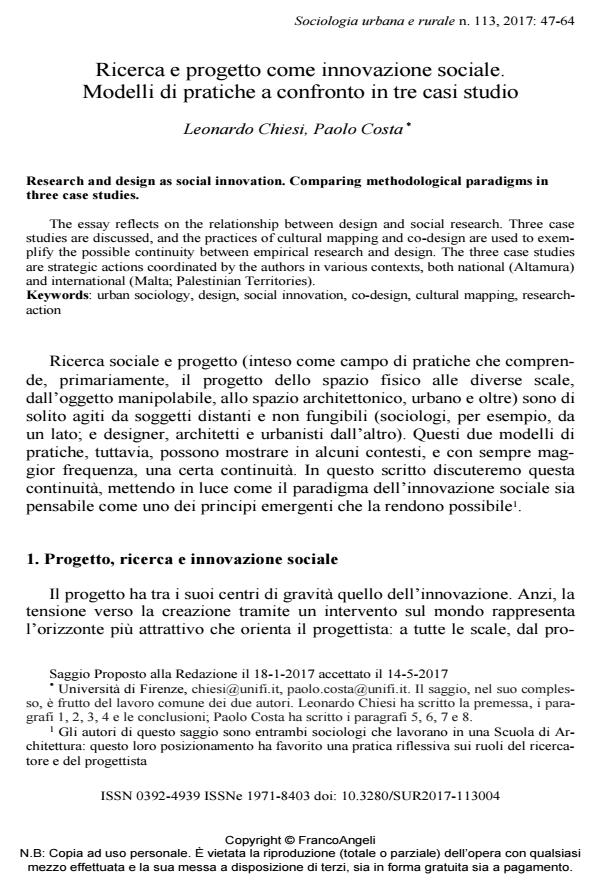Research and design as social innovation. Comparing methodological paradigms in three case studies
Journal title SOCIOLOGIA URBANA E RURALE
Author/s Leonardo Chiesi, Paolo Costa
Publishing Year 2017 Issue 2017/113
Language Italian Pages 18 P. 47-64 File size 806 KB
DOI 10.3280/SUR2017-113004
DOI is like a bar code for intellectual property: to have more infomation
click here
Below, you can see the article first page
If you want to buy this article in PDF format, you can do it, following the instructions to buy download credits

FrancoAngeli is member of Publishers International Linking Association, Inc (PILA), a not-for-profit association which run the CrossRef service enabling links to and from online scholarly content.
The essay reflects on the relationship between design and social research. Three case studies are discussed, and the practices of cultural mapping and co-design are used to exem-plify the possible continuity between empirical research and design. The three case studies are strategic actions coordinated by the authors in various contexts, both national (Altamura) and international (Malta; Palestinian Territories).
Keywords: Urban sociology, design, social innovation, co-design, cultural mapping, research-action
- Amendola G. (a cura di). (2009). Il progettista riflessivo. Scienze sociali e progettazione architettonica. Bari: Laterza.
- Azzam A.M. (2009). Why Creativity Now? A Conversation with Sir Ken Robinson. Educational Leadership, 67: 22-26.
- Bifulco L. (2013). Governance e partecipazione. In Vicari S. (a cura di) Questioni urbane. Caratteri e problemi della città contemporanea. Bologna: il Mulino.
- Chiesi L. (2010). Il doppio spazio dell’architettura. Ricerca sociologica e progettazione. Napoli: Liguori.
- Chiesi L. (2011). Paesaggio, territorio e popolazione. Due nodi problematici. In Paolinelli G. (a cura di). Habitare. Il paesaggio nei piani territoriali. Milano: FrancoAngeli.
- Chiesi L. (2016). Territoriality as appropriation of space. How «engaging with space» frames sociality. In Dessein J., Battaglini E., Horlings L. (Eds). Cultural Sustainability and Regional Development. London: Routledge.
- Chiesi L., Costa P. (2015). One strategy, many purposes. A classification for cultural mapping projects. In Duxbury N., Garrett-Petts W., MacLennan D. (Eds). Cultural Mapping as Cultural Inquiry. London: Routledge.
- Chiesi L., Costa P. (2016). Making territory through cultural mapping and co-design. How community practices promote territorialisation. In Dessein J., Battaglini E., Horlings L. (Eds). Cultural Sustainability and Regional Development. Theories and practices of territorialisation. London: Routledge.
- Clifford S., King A. (Eds) (1996). From Place to PLACE: Maps and Parish Maps. London: Common Ground.
- Corbellini G. (2011). Scienza, quindi democrazia. Torino: Einaudi.
- Corbett J. (Editor) (2009). Good practices in participatory mapping. Roma: Ifad.
- Costa P. (2014). Valutare l’architettura. Ricerca sociologica e Post-Occupancy Evaluation. Milano: FrancoAngeli.
- Delgado M. (2015). Urban youth and photovoice: Visual ethnography in action. Evaluation. New York: Oxford University Press.
- Duxbury N., Garrett-Petts W., MacLennan D. (a cura di) (2015). Cultural Mapping as Cultural Inquiry. London: Routledge.
- Gallino L. (2014). Tecnologia e democrazia. Torino: Einaudi.
- Garramone V., Aicardi M. (2010). Paradise l'OST? Spunti per l'uso e l'analisi dell'Open Space Technology. Milano: FrancoAngeli.
- Groat L. (2000). The architect as artist or scientist? A modest proposal for the architectas-cultivator. In Moore K.D. (Ed.) Culture, Meaning, Architecture. Critical Reflections on the Work of Amos Rapoport. Burlington: Ashgate.
- Lewin K. (1946). Action Research and Minority Problems. Journal of Social Issues, 2: 34-46.
- Magnaghi A. (2000). Il Progetto locale. Torino: Bollati Boringhieri.
- Magnaghi A. (2010). Montespertoli: le mappe di comunità per lo statuto del territorio. Firenze: Alinea.
- Moulaert F., MacCallum D., Mehmood A., Hamdouch A. (2013). General Introduction: The Return of Social Innovation as a Scientific Concept and a Social Practice. In Moulaert F., MacCallum D., Mehmood A., Hamdouch A. The International Handbook on Social Innovations. Cheltenham, UK: Edward Elgar.
- Nicholls A., Murdock A. (2012). The Nature of Social Innovation. In Social Innovation. Blurring Boundaries to Reconfigure Markets. London: Palgrave Macmillan.
- Owen H. (2008). Open Space Technology: A User's Guide. Oakland, CA: Berrett-Koehler.
- Panza M.O. (2008). L'architettura delle camere urbane. Potenza: Grafie.
- Pavlides E., Cranz G. (2009). Three Theoretical Assumptions Needed to Create Useful Applied Social Science Research for Architecture. International Journal of Interdisciplinary Social Sciences, 4: 191-202.
- Raffestin C. (1984). Territorializzazione, deterritorializzazione, riterritorializzazione e informazione. In Turco A. (a cura di). Regione e regionalizzazione. Milano: FrancoAngeli.
- Rapoport A. (1982). The Meaning of the Built Environment: A Nonverbal Communication Approach. Beverly Hills, CA: Sage Publications.
- Rapoport, A. (2013). History and precedent in environmental design. New York: Plenum Press.
- Rizzo F. (2009). Strategie di co-design. Teorie, metodi e strumenti per progettare con gli utenti. Milano: FrancoAngeli.
- Sanders E.B-N., Stappers P.J. (2008). Co-creation and the New Landscapes of Design. Co-Design, 4: 5-18. DOI: 10.1080/1571088070187506
- Scott R. (2007). Institutions and Social Innovation. In Hamalainen T.J., Heiskala R. (Editors). Social Innovations, Institutional Change and Economic Performance. Cheltenham, UK: Edward Elgar.
- Serrini G. (a cura di) (2012). Bethlehem Area Conservation and Management Plan. The Plan as an Alphabet. Paris: UNESCO.
- Shelby R., Perez Y., Agogino A. (2012). Partnering with the Pinoleville Pomo Nation: Co-Design Methodology Case Study for Creating Sustainable, Culturally Inspired Renewable Energy Systems and Infrastructure. Sustainability, 4: 794-818.
- Stevens G. (1998). The Favored Circle. The Social Foundations of Architectural Distinctions. Cambridge, Mass: MIT Press.
- Stewart S. (2007). Cultural Mapping Toolkit. Vancouver: Creative City Network of Canada and 2010 Legacies Now.
- Strack R., Magill C., McDonagh K. (2004). Engaging youth through photovoice. Health Promotion Practice, 5(1): 49-58. DOI: 10.1177/152483990325801
- Vicari Haddock S. (a cura di) (2013). Questioni urbane. Caratteri e problemi della città contemporanea. Bologna: il Mulino.
- Wang C. (2006). Youth participation in photovoice as a strategy for community change. Journal of Community Practice, 14: 147-161.
- Università imprenditoriale e innovazione sociale a Milano e Venezia Maurizio Busacca, in ECONOMIA E SOCIETÀ REGIONALE 3/2018 pp.109
DOI: 10.3280/ES2018-003010
Leonardo Chiesi, Paolo Costa, Ricerca e progetto come innovazione sociale. Modelli di pratiche a confronto in tre casi studio in "SOCIOLOGIA URBANA E RURALE" 113/2017, pp 47-64, DOI: 10.3280/SUR2017-113004